“WE’RE GOING TO HAVE to split up,” I said, looking steadily at my son. “The hunting’s been tough, and we need to cover more country.”
It didn’t surprise me that he seemed fine with the idea. Josiah is 14 and, having been raised on a remote cattle ranch, more capable than many grown men. He’s used to dawn-to-dark days on horseback working half-wild cattle, shooting rattlesnakes, and building fence. And he’s been hunting since he was big enough to keep both ends of a rifle out of the dirt.
But he’d never hunted big game alone before. This would be the first time he ever stalked the hills solo in search of a buck to put his tag on, the first time I wouldn’t be there to help range the animal and spot his hit for him. The first time he had to put it all together.
It took only a few moments to formulate a plan. He would still-hunt around some ledges to a point overlooking a hidden bench above a desert canyon. Then he’d sit and watch until dark. I would stalk around the other side of the mountain to watch a big sagebrush flat. We’d hook up after dark for the 2-mile hike to camp.
We separated then, me feeling oddly conflicted as I watched him stride away, his long legs eating up the sand. He apparently felt no nostalgia, but to me it signaled a simultaneous destination reached and journey begun. I was now the old hunter, the wise one who theoretically worked less and killed more, but whose step was slower, whose eyes were no longer as keen. He was the young hunter who could run with the wind and hunt with the stamina of a hound. Still, I looked forward to hearing him recount his hunt around the campfire that night.
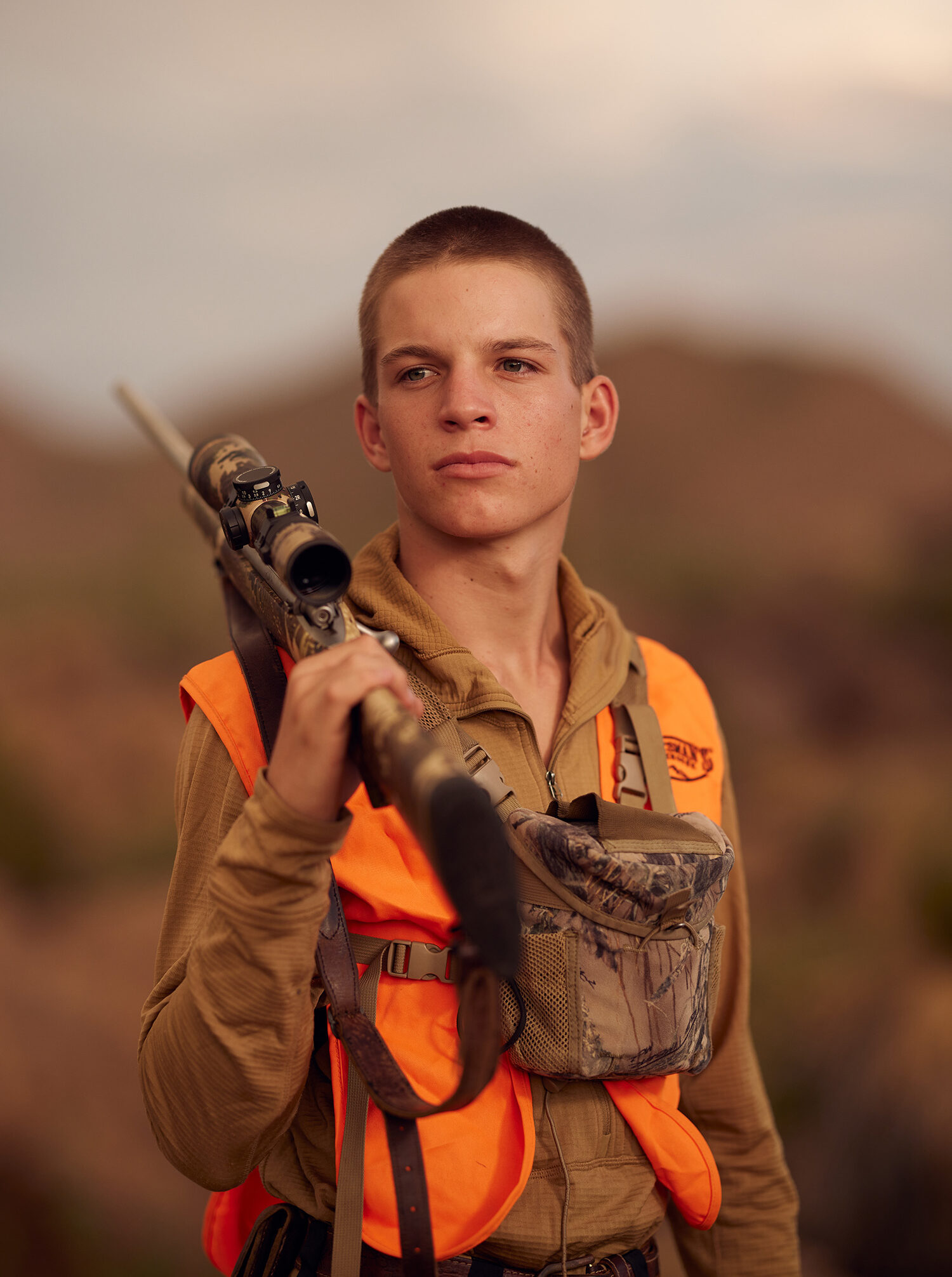
A Distant Shot
Hunting slowly through the brush, I skirted an open hollow and climbed through some sandstone ledges. Flakes of flint and broken pottery lay scattered on the wet sand. I topped out on a little ridge and detoured around an old ruin, the tumbled stone walls forming multiple rooms. It was fascinating and I felt like lingering. But the sun was already descending the western sky, and I needed to hunt. Moving stealthily along, I reached the rim overlooking my sage flat. Five does already fed among the head-high sagebrush. Sitting down with my back against a piñon, I settled in to watch. That’s when I heard the shot.
The sound came from Josiah’s direction, over the ridge. Almost breathless, I waited. A couple of minutes crept by and then I heard another shot. Scrambling to my feet, I shouldered my pack and caught up my rifle. Josiah had already found a shooter buck.
In this remote desert, where we carry heavy packs, sleep in tiny tents atop the sand, and haul our drinking water several miles from a distant spring, we don’t shoot young bucks. Instead, we wait and hunt—searching for mature bucks, ripe for the harvesting and worth the effort. Carrying a deer out of this rugged place is a huge undertaking. So if Josiah had decided to shoot one, it was probably a really good buck.
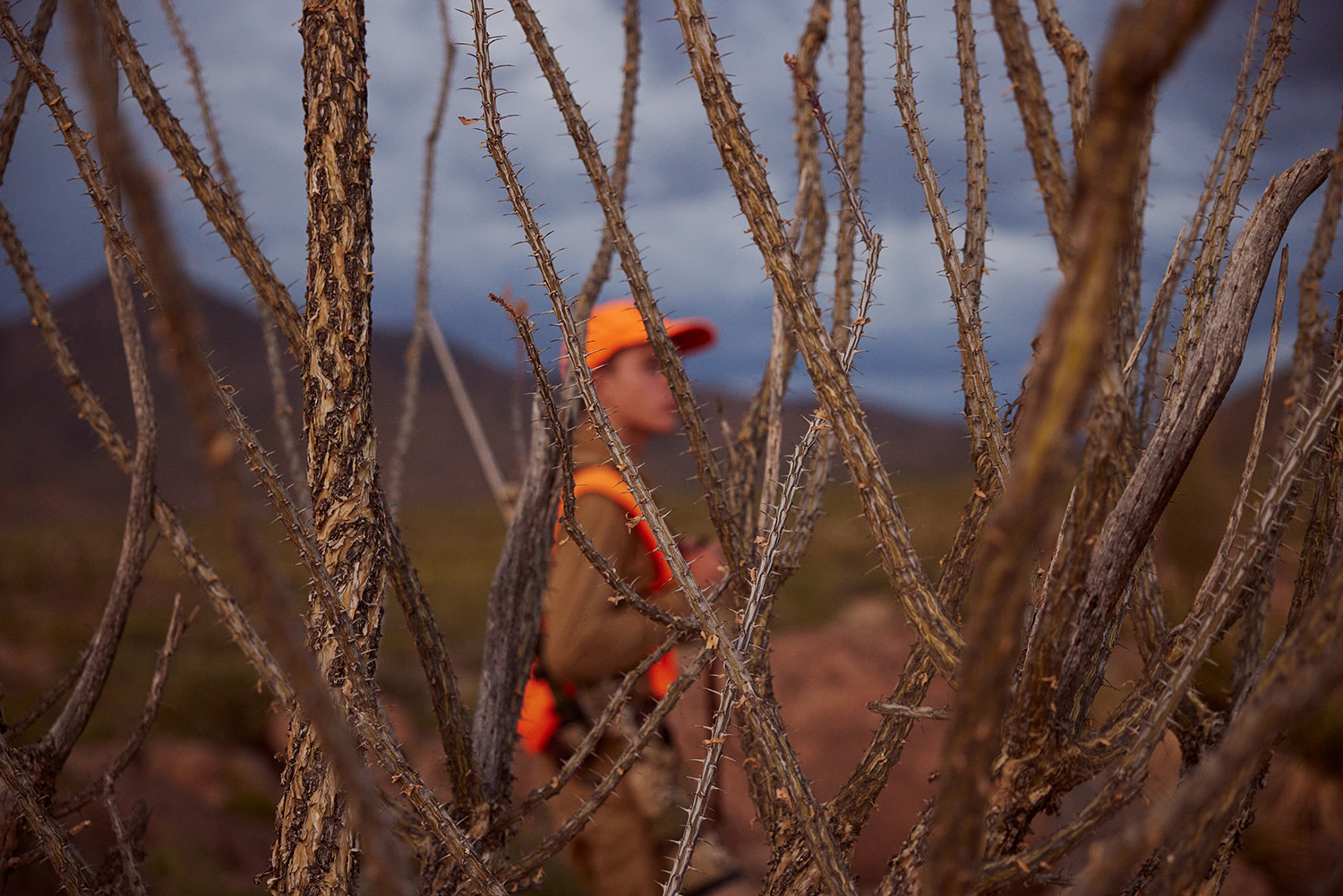
Jim, our friend and third member of our party, had shot a big buck on our second day here. There had been five fresh inches of snow on the ground and a lowering sky, storm clouds ominous as they retreated into the north. The buck offered Jim an easy shot, only a hundred yards from the point he’d climbed to sit and glass the evening away. That was the only mature buck we’d seen in four days of hunting. As I trotted through the piñon and juniper forest, I couldn’t wait to see what kind of buck Josiah had spotted.
Many experienced hunters share the opinion that a mature mule deer buck is the hardest quarry in the lower 48. Not only are they scarcer than hen’s teeth, they are also very difficult to kill. Once a buck has made it past his fourth year he loses his sense of humor completely and becomes largely nocturnal. A hunter must be very good or very lucky to find and kill him, especially on public land. A mule deer buck reaches his peak during years six, seven, and eight. Finding and harvesting a buck of that age may mark the pinnacle of a hunter’s career.
All this swirled in the back of my mind as I trotted toward Josiah’s position atop the ridge. I found him casting about, examining fresh tracks in the damp sand, searching for any sign of blood. There was none. The sun was setting as he told me his story—and I knew that the lessons he learned from this evening hunt would stay with him all his life.
A Costly Mistake
Josiah had barely settled onto his perch when four bucks showed up, feeding into the opposite edge of the hidden bench he overlooked. Belly down on a sandstone slab, he ranged the biggest buck and adjusted his scope turret to the appropriate range. He was ready, but the deer were feeding toward him through thick brush and piñon-juniper forest, and for 15 minutes or more he didn’t have a shot. Watching through his scope, he waited patiently for the right angle. Finally, the big buck offered a good quartered-to shot, and Josiah pressed the trigger.
The bucks scattered like so many quail, and then some of them went back to feeding. The big buck started out of the basin, but Josiah wasn’t sure it was the same deer. Not wanting to accidentally shoot two bucks, he waited until he could confidently identify the deer. As soon as he did, he shot again. The deer bounded out of the basin and was gone—untouched.
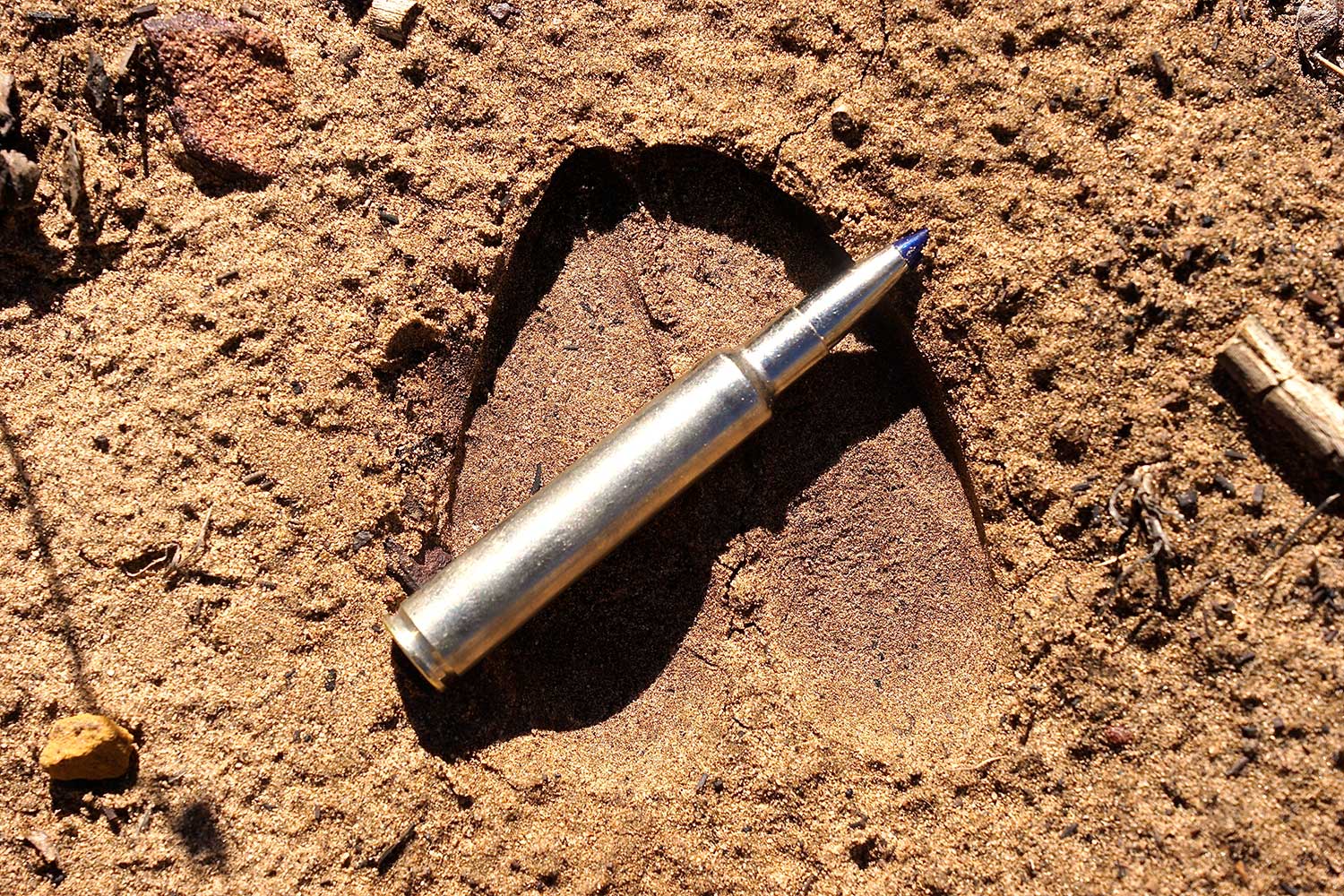
Missing is unusual for Josiah, so I quizzed him on the details and we unraveled what had happened. When the bucks first appeared they were over 400 yards distant. Josiah cranked his turret to the appropriate range and then settled into his scope to wait for the right shot. Since he was watching through the scope (with only one eye, which results in a loss of depth perception) he failed to notice that the buck had moved much closer during the 15 minutes he waited. When he finally pressed the trigger, the deer was about 300 yards away. Both bullets sailed right over the deer’s back.
Josiah was a sad young hunter that night, and quiet. Jim and I managed to extract a detailed description of the buck, and after hearing it I understood why he was so disappointed. It seems the buck had heavy, tall antlers with bladed tines, and some extra points as well. It was just the kind of buck we had backpacked miles into the backcountry to find.
Another Encounter
Second chances are not common in the hunting world, especially when hunting mule deer on public general-season areas. But Josiah wanted to try, so once more we parted ways: me sneaking toward my sage flat, him on a quest to relocate his big buck.
As he skirted an open ridge-side basin en route to his vantage point, Josiah spotted the fresh tracks of several bucks feeding through the sandy basin. One of the tracks was big and wide and deep. It looked like the spoor left by the gnarly buck he had missed the night before. With hope in his heart and the eagerness of a hound pup on his first lion track, Josiah chambered a cartridge and began to sort out the trail.
Across the basin he went, meandering through the short brush and up the far side, always following the fresh sign. He saw where the deer had stopped to feed on bitterbrush, tracing their spoor from bush to bush. A low ridge formed the far side of the basin and sported a balding fringe of piñon and juniper. Into this led the tracks.
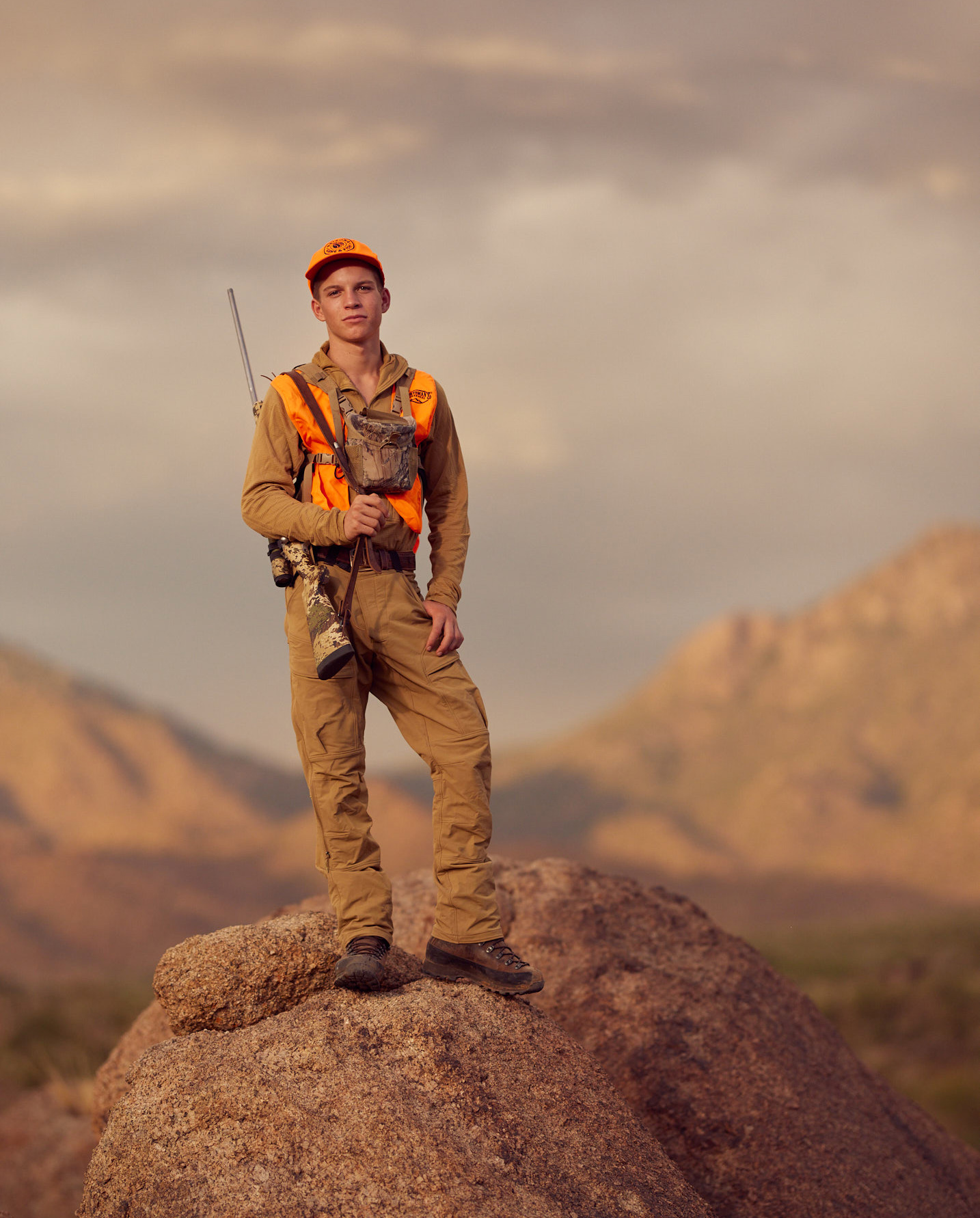
Easing along on high alert, watching for sign that the bucks were ready to settle down and bed for the day, Josiah glanced ahead. Not 70 yards distant a buck stood, staring at him in surprise. It didn’t appear to be his big buck, but Josiah began to slowly raise his rifle in readiness.
The movement was too much for the buck and he blew out, bounding in great leaps down the undulating top of a long, low ridge. Several more bucks followed, clearing the sage in huge, ground-devouring jumps. One of them was the big nontypical Josiah had missed the night before.
Eventually the deer began circling back toward the high-level basin. The tracks indicated the bucks, no longer bounding, were in a dogtrot, headed toward where he’d missed the night before. Josiah followed, watching the tracks, studying the basin ahead. And then there they were, walking steadily up the far side in single file.
Shot full of adrenaline, Josiah ran, fish-hooking around to try to get into position for a shot. But they were gone, their tracks telling the story of a rapid exit. Hope still strong, he took up the trail once more. Down the ridge he went, through more piñon and juniper and across a flat of old burned brush, the tracks in the damp sand beckoning him onward.
The Big Nontypical
I was hunting along the far side of the big ridge and across the wind when I heard the faint sound of a shot. That was all, and for long minutes I stood and waited, studying the shadowy slopes and watching for deer moving through the brush. Nothing showed, and at length I reached into my pack and dug out my radio. Pressing the button, I called for my son.
“I think I got him! The big buck from last night!”
“No way!” I responded. “What do you mean, you think?”
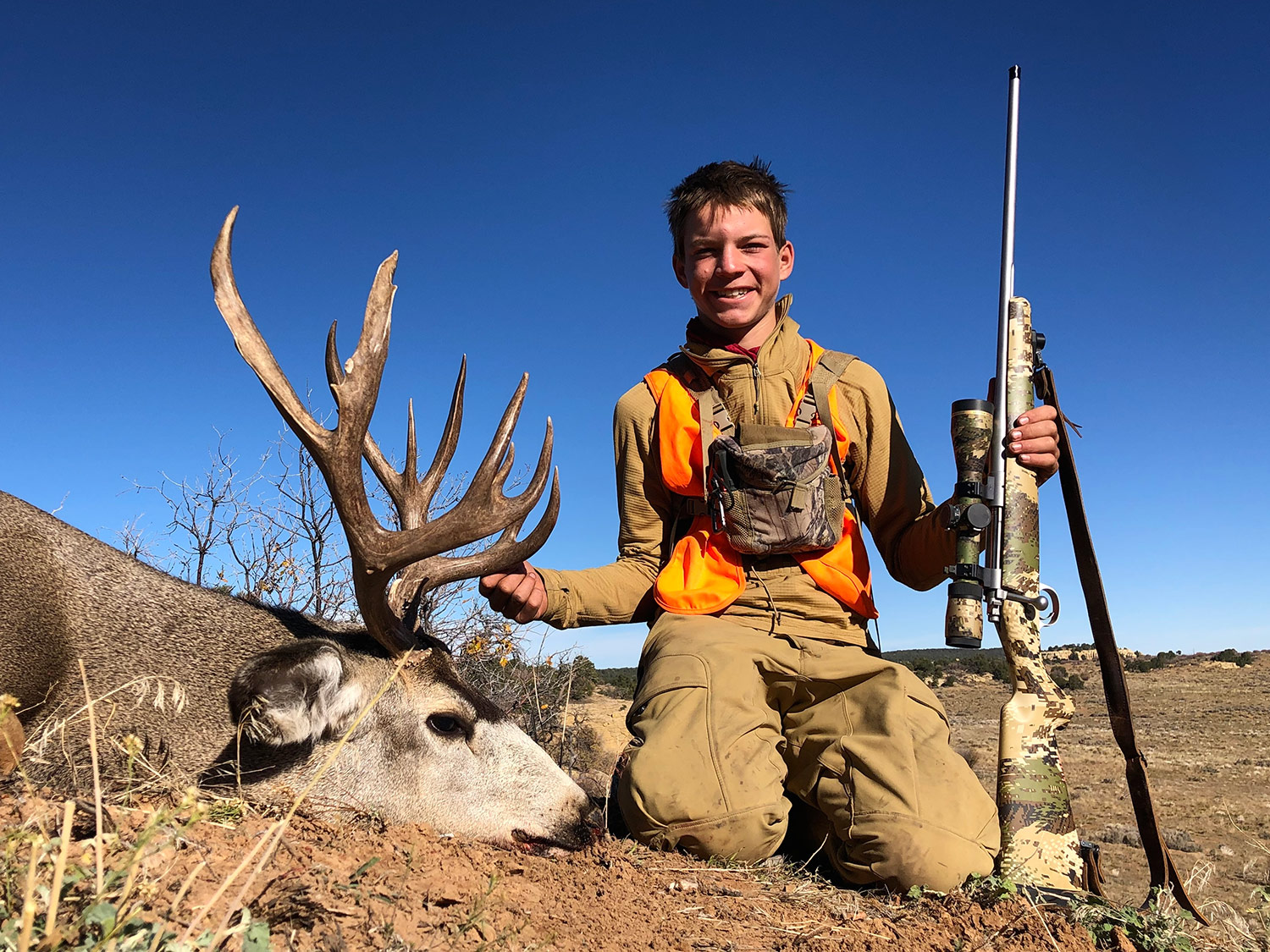
“I hit him twice. I’m pretty sure I saw him go down in the shade of a big piñon, but not 100 percent positive. I’m going to go check now.”
In a ragged, heart-pounding trot I pointed my boots toward the high basin. I realized with surprise that Josiah had told me he fired three times, hitting the buck twice. Due to the intervening topography and the wind, I’d only heard one of the shots.
I was almost across the crest of the ridge when I heard one final shot. It had a good sound to it—a conclusive sound—and moments later Josiah appeared below me through the brush, an ecstatic expression on his young face. Trotting ahead, my middle-aged lungs heaving for air, I saw what all the excitement was about.
Thick, bladed tines reached skyward, deep forks and massive main beams gleaming in the morning sunshine. The buck’s body was thick and fat and healthy, his hair the smooth gray of an early winter coat. Josiah and I celebrated and exclaimed over the massive buck. We knelt to offer a simple prayer of gratitude. And then we stood and celebrated all over again.
It was Josiah’s first-ever big-game animal harvested alone and unassisted. He’d been given a second chance at an already challenging opportunity and possessed the skills and tenacity to make the best of it. He’d proven himself as a hunter: to himself, to me, and to the wilderness. In the eyes of the old hunter-gatherer people who once lived here, he was now a man and capable of providing.
We took photos and savored the moment, taking time to file away memories. Then it was time to start processing the buck. I asked if he wanted help.
“I can do it,” he replied. “You go hunt some more. I kinda want to do the whole thing myself.”
That was OK with me. He’d earned it, and I could use a few minutes alone myself. Still wearing a smile, I wandered off into the woods. A piece of ancient pottery caught my eye, left there by other hunters a thousand years ago. I picked it up, studying the intricate patterns painted in black and white.
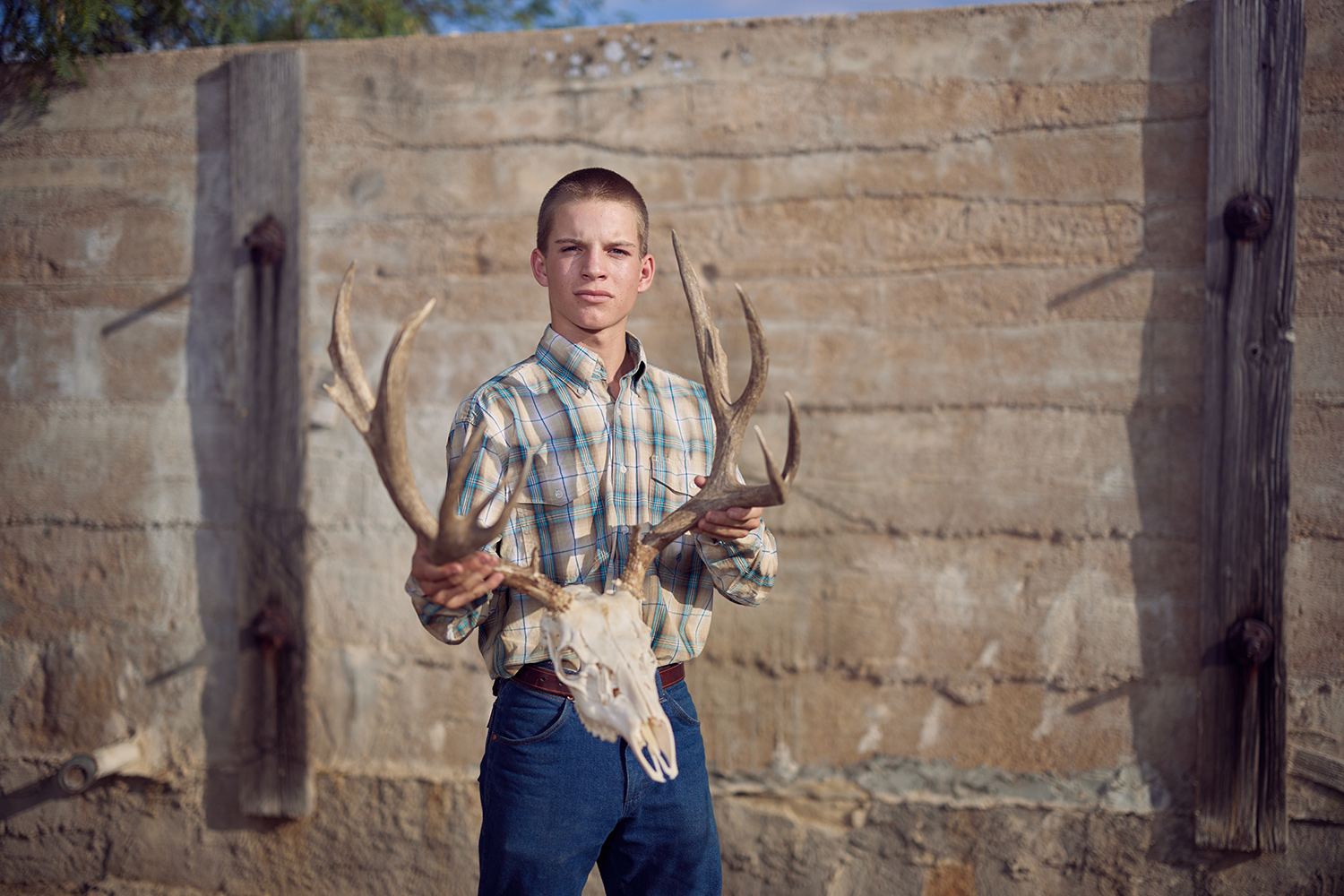
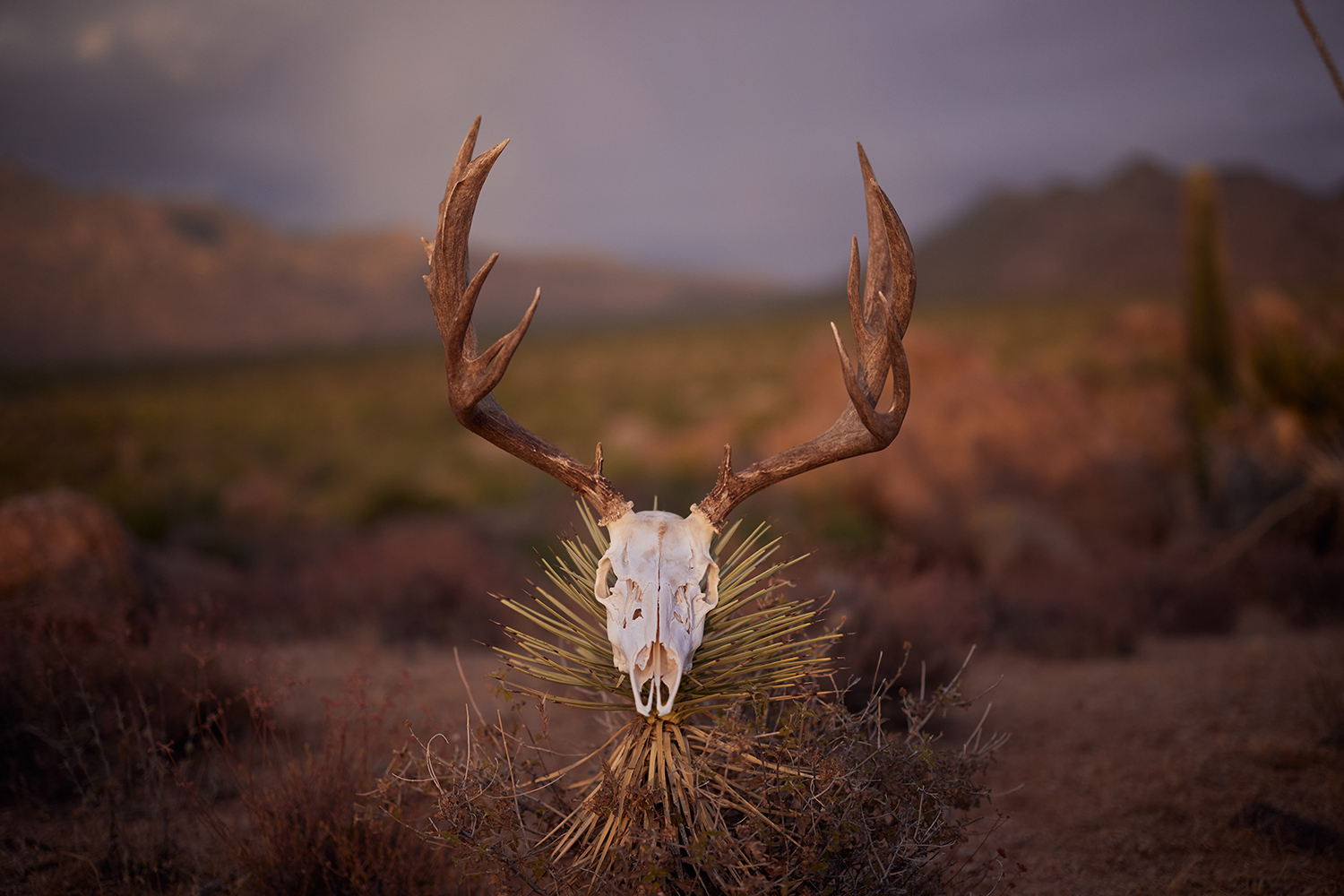
I couldn’t keep my attention on looking for deer, and I found myself following my feet back toward the kill. Wandering around nearby, I picked up the big buck’s tracks and backtrailed them down the hill and into the basin, going the direction he had come from. The tracks were big and deep and his stride was long. I noted their appearance; it would help me identify the tracks of similar-aged bucks during future hunts. Back at the kill site I rested and talked to Josiah as he worked. I needed details of the final encounter.
When he spotted the bucks working single file up the far side of the basin, Josiah had immediately gotten prone, snapping his bipod into place for support. In his excitement Josiah felt like the big buck wouldn’t stop and offer him a standing opportunity, so he shot at the walking deer. Hard-hit, the buck bounded up to a shelf and bedded. Josiah fired again, holding on the bedded buck’s vitals. The deer leapt up and headed for the piñon and juniper timber, and Josiah hit him again just as it disappeared into the shadows. Then he slipped into the woods and administered the coup de grâce.
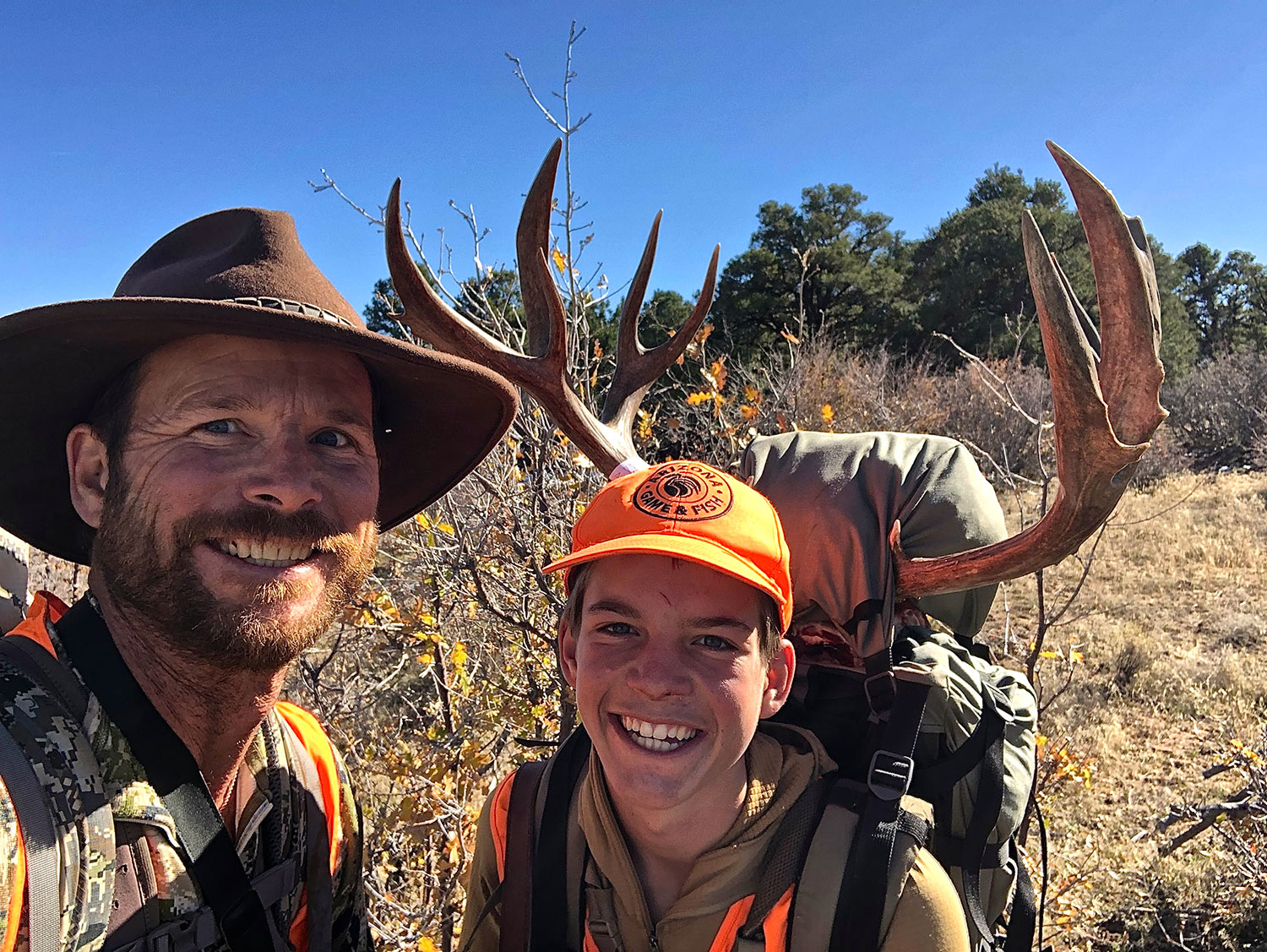
It wasn’t his characteristic good shooting, and gently I pointed out that had he waited, the buck would almost certainly have paused to catch its breath during the short climb out of the basin. That would have been the right time to make a careful, one-shot kill. Even so, I was as pleased with my son as a father could possibly be, and I told him so. I watched him skin and quarter his buck, and I dozed in the sunshine. When Josiah finished his work we turned toward camp, our packs heavy with venison. Carrying meat is an honorable job, and one to be shared.
The days passed. We searched for another big buck that never materialized, and Jim and Josiah made multiple trips out to the truck, laden with meat. The hunt came to an end and we broke camp, loaded our packs, and headed out of the wilderness.
Watching Josiah carry his load across the jagged desert terrain, his step still springy and strong, I knew he was a force to reckon with. We still have mountains to climb and tracks to follow, he and I. But in time I will become old and sit by the fire and dream of hunts gone by while he ventures into the cold and wild, returning with meat for the table and stories to share with me. It was, to my surprise, a good thought.
Read more OL+ stories.
